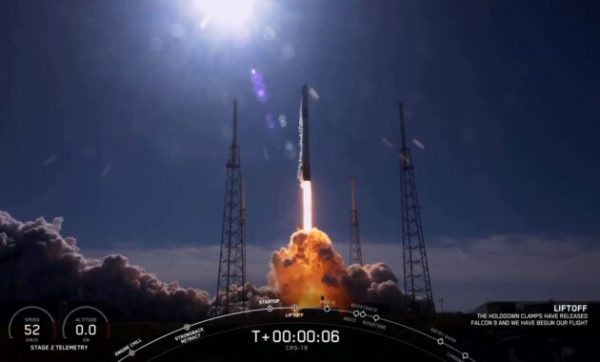SpaceX launches Dragon cargo craft with mighty mice and a tricky shipment for Seattle’s Spaceflight – GeekWire

A fresh SpaceX Falcon 9 rocket launched a recycled robotic Dragon cargo capsule today, carrying 5,700 pounds of supplies, satellites and science to the International Space Station.
In contrast with Wednesday’s planned launch attempt, which was called off due to excessively high upper-level winds, today’s countdown proceeded smoothly to liftoff at 12:29 p.m. ET (9:29 a.m. PT) from Cape Canaveral Air Force Station in Florida.
Minutes after launch, the Falcon 9’s first stage fell away as planned and flew itself back for touchdown on a drone ship stationed hundreds of miles out in the Atlantic Ocean. SpaceX went with an at-sea landing of the first stage today so that it could put the second stage through a long-duration thermal test.
The Dragon cargo craft, meanwhile, continued onward toward the space station for SpaceX’s 19th cargo resupply mission under a multibillion-dollar contract with NASA. It’s due to rendezvous on Sunday and will be pulled in for a berthing using the station’s robotic arm.
SpaceX routinely recovers and reuses its Falcon 9 first-stage boosters, but today’s launch was the first for this particular booster. In contrast, the Dragon capsule launched today has been used twice before for space station resupply, in September 2014 and June 2017.
The Dragon’s payloads include a squadron of 40 mice that will be used in an experiment studying ways to block muscle loss in space; barley seeds that will be put through the malting process to learn how to brew beer in zero-G; a Japanese hyperspectral imager; and a trio of nanosatellites that Seattle-based Spaceflight has arranged to be passed along from one cargo ship to another.
- The latest in a series of “mighty mice” experiments will study mice that have been genetically engineered so that they don’t produce a protein known as myostatin, which inhibits muscle growth. Their development in zero-G will be compared with normal mice that have been given a drug to block myostatin activity. The findings could help scientists combat muscle-wasting in zero-G, which is an occupational hazard for astronauts on long-duration missions.
- Anheuser-Busch’s Budweiser brand has been conducting a series of commercial experiments on the space station to study beer-brewing processes in the zero-G environment. This fourth experiment focuses on the malting process, in which barley seeds are germinated and then dried out. Such experiments could help researchers develop strains of barley that are better-suited for consumption (as grain or as beer) during long-duration space missions.
- The Japanese Aerospace Exploration Agency’s Hyperspectral Imager Suite, also known as HISUI, will be transferred from the Dragon’s unpressurized trunk to the space station’s exterior, using the station’s robotic arm. From that vantage point, HISUI will gather high-resolution Earth observations in multiple wavelengths. Such observations could be used to monitor crops and forests, or to identify valuable energy and mineral resources.
Spaceflight’s arrangement for the SEOPS-2 mission, worked out in cooperation with Hypergiant SEOPS, illustrates how commercial cargo operations involving the space station are getting more sophisticated.
There are two CubeSats built with NASA’s support — a compact infrared radiometer and a student-built Earth observation satellite — plus a research satellite for the Pentagon’s Defense Advanced Research Projects Agency.
SpaceX’s Dragon will drop off the satellites at the space station, where they’ll be transferred to a Northrop Grumman Cygnus cargo ship that’s already berthed to the station. The satellites will be deployed into a roughly 300-mile-high orbit from the Cygnus after its departure from the station in January.
Such a handover was done successfully for the first time in August, for SEOPS-1.
“This unique approach to launch from the ISS has proven to be a valuable option for customers looking for a high-altitude deployment,” Spaceflight CEO Curt Blake said in a news release. “After the success of our SEOPS-1 mission, we were eager to execute another with Hypergiant. These launches are particularly appealing to our customers because of the reliability of the launch vehicles, cost-effectiveness and consistency in the launch schedule.”
Once the Dragon is hooked up to its docking port, the space station’s crew will unload the cargo, and then load it back up with payloads to be returned to Earth early next year .






